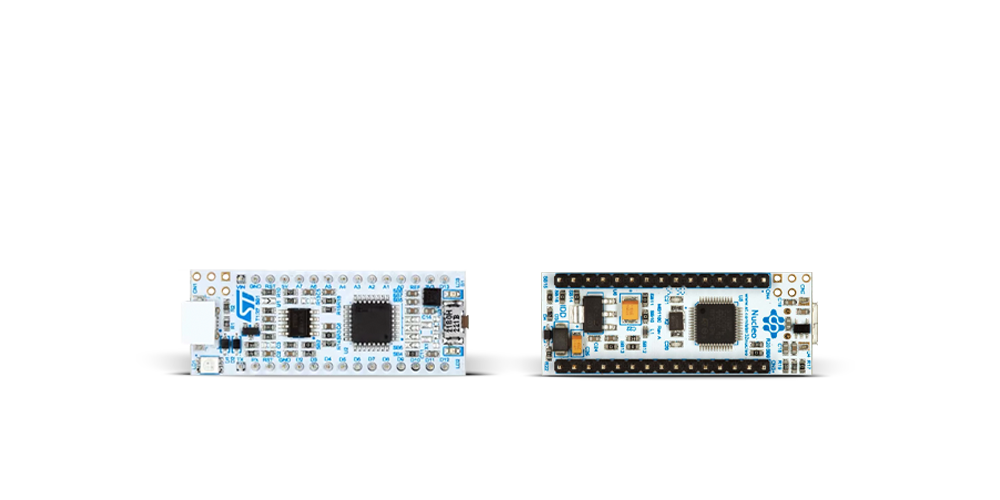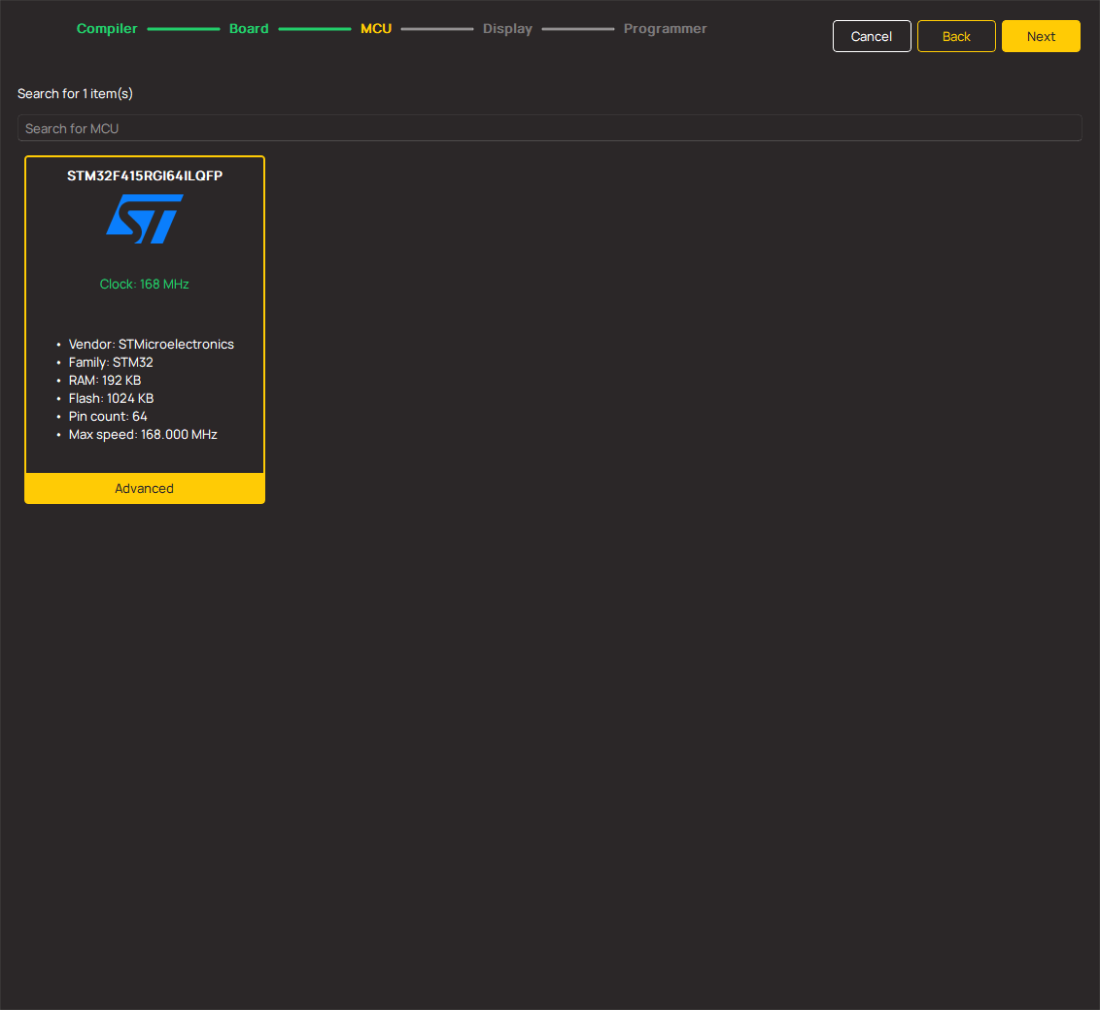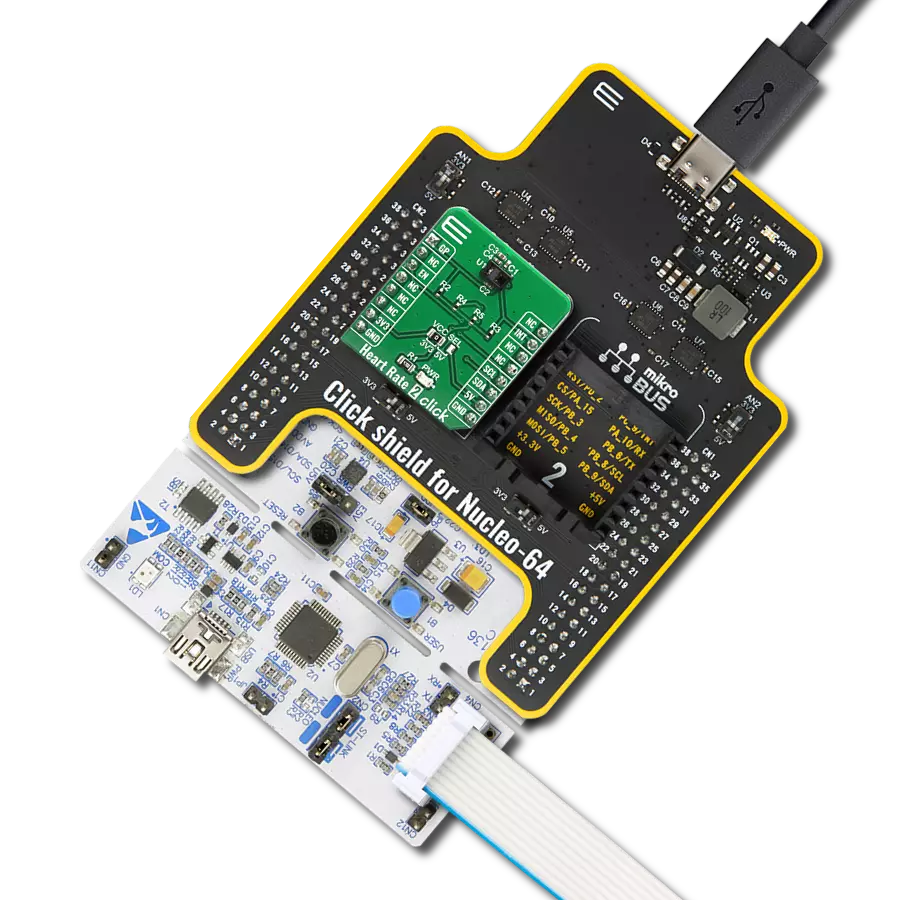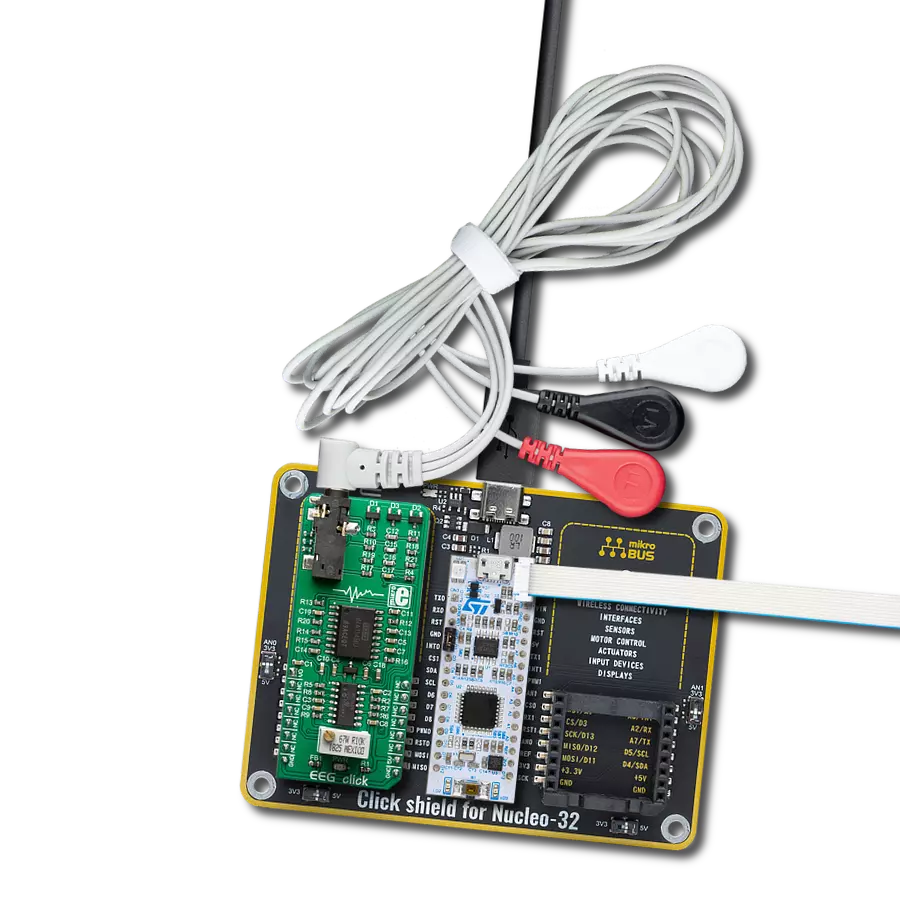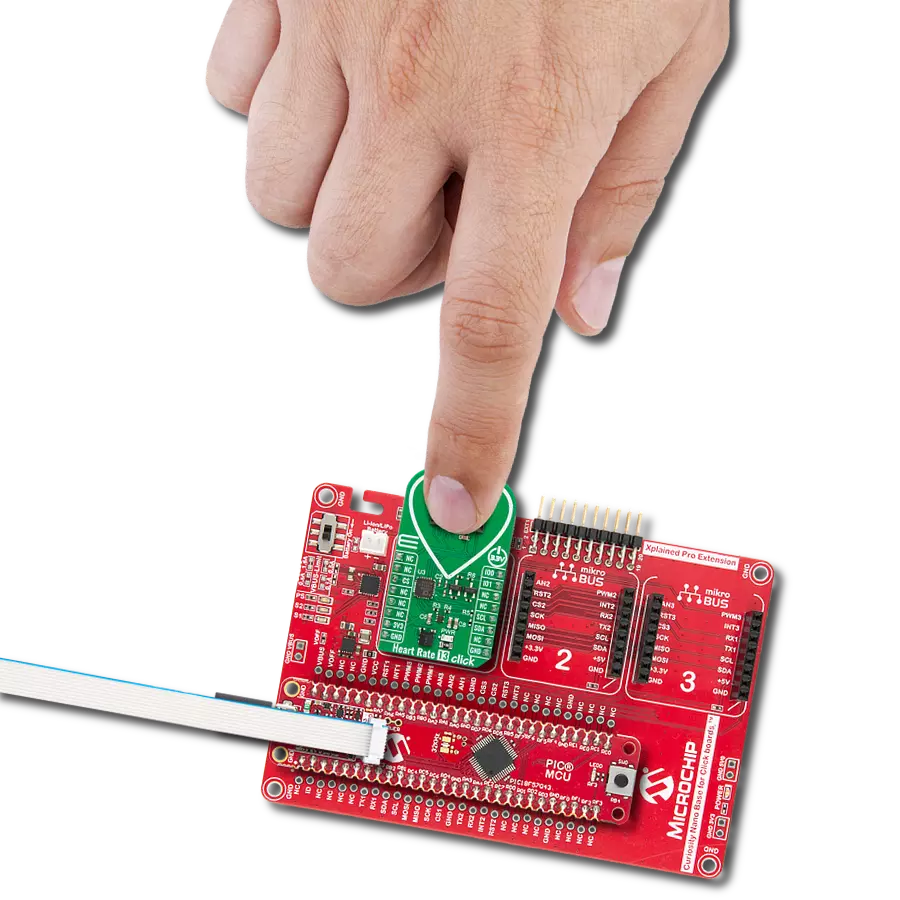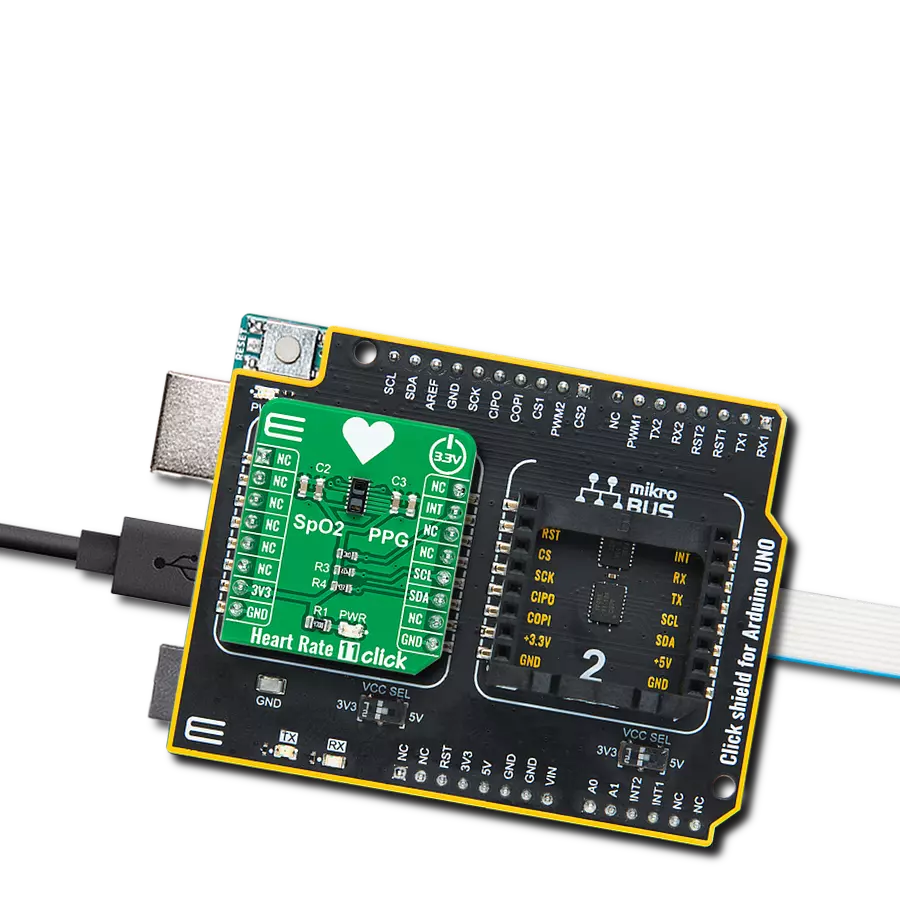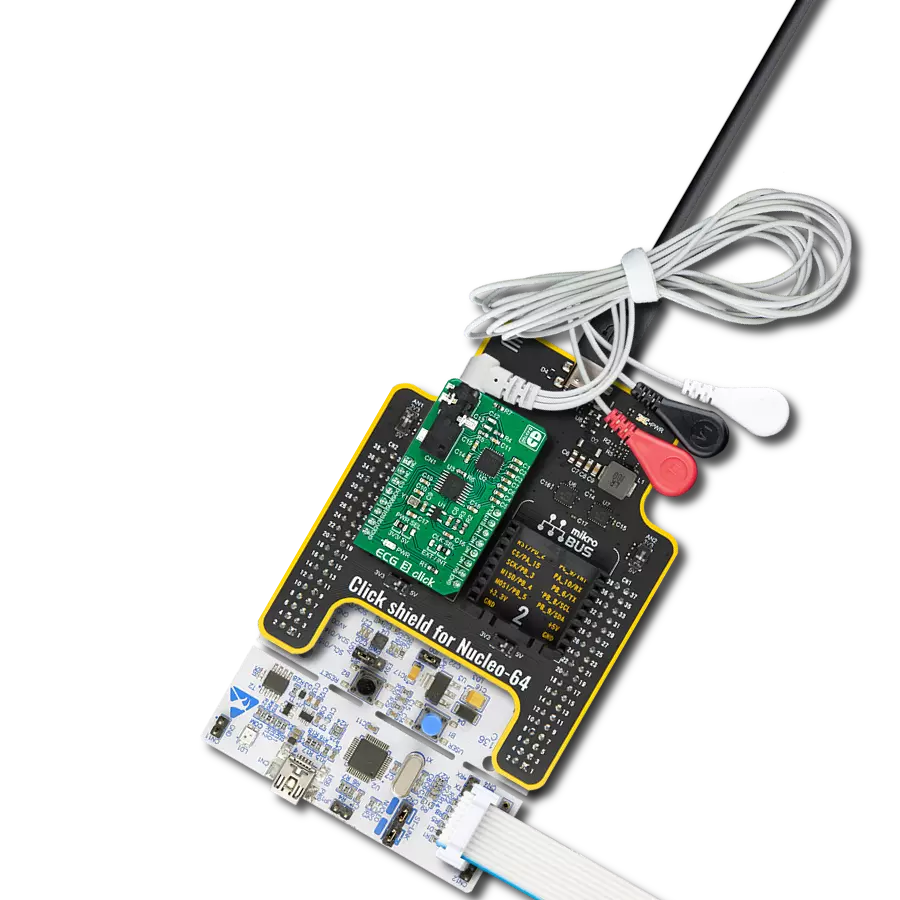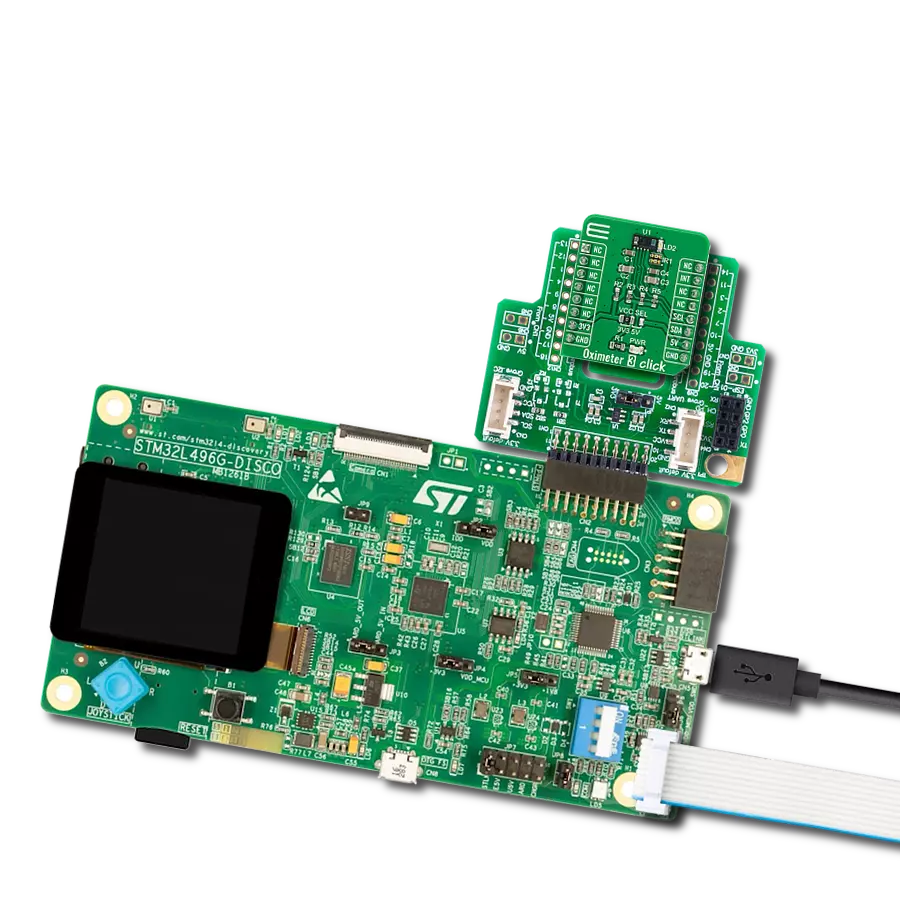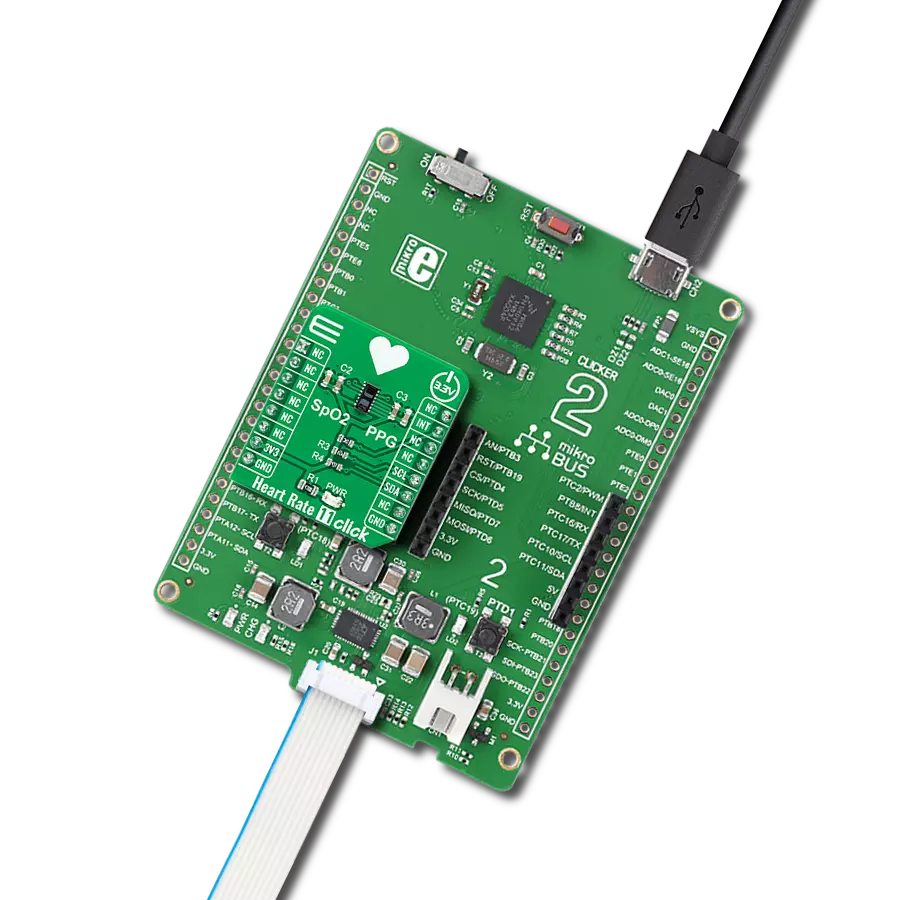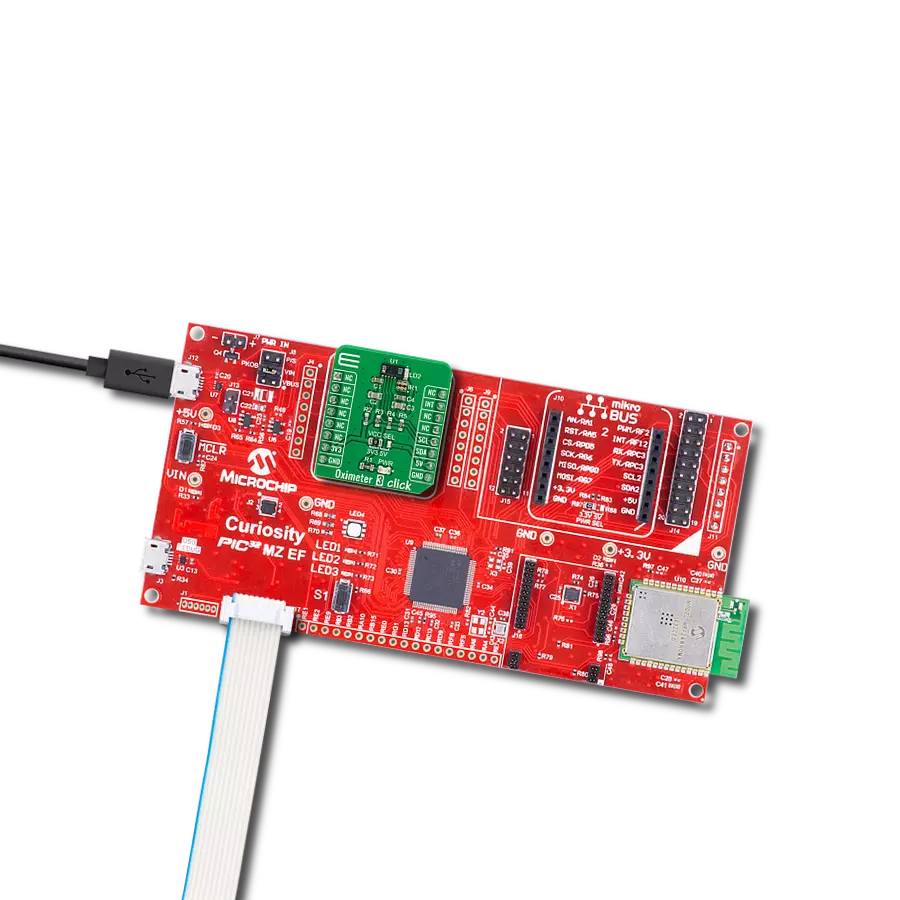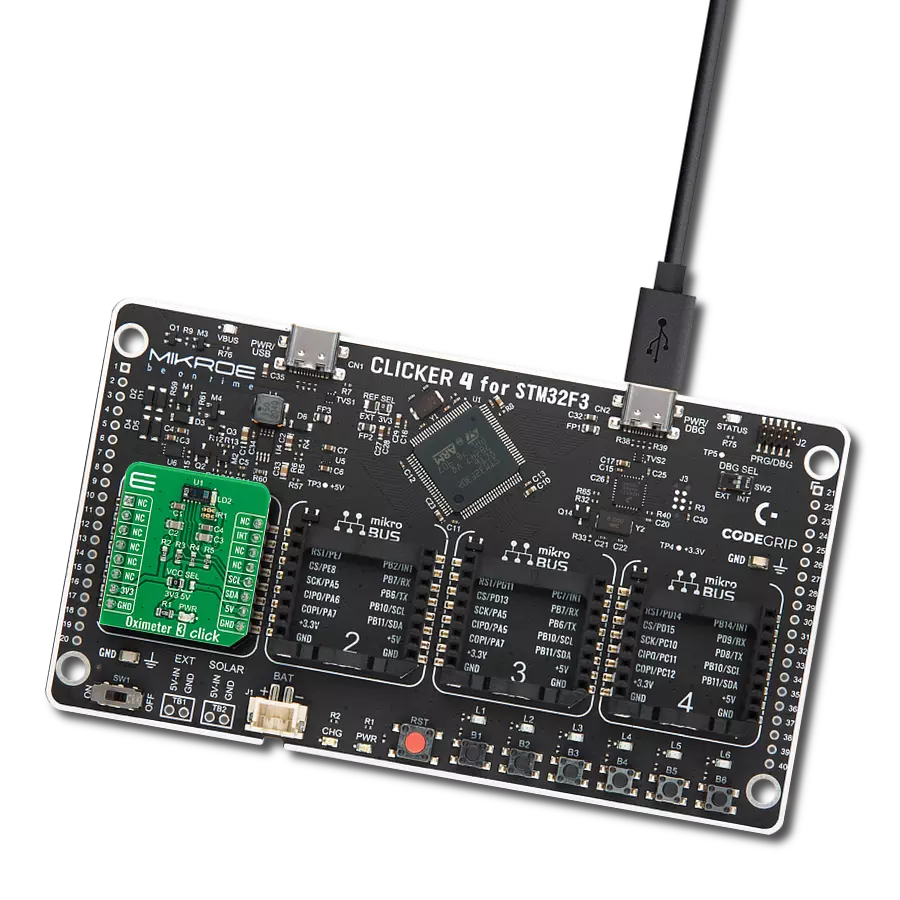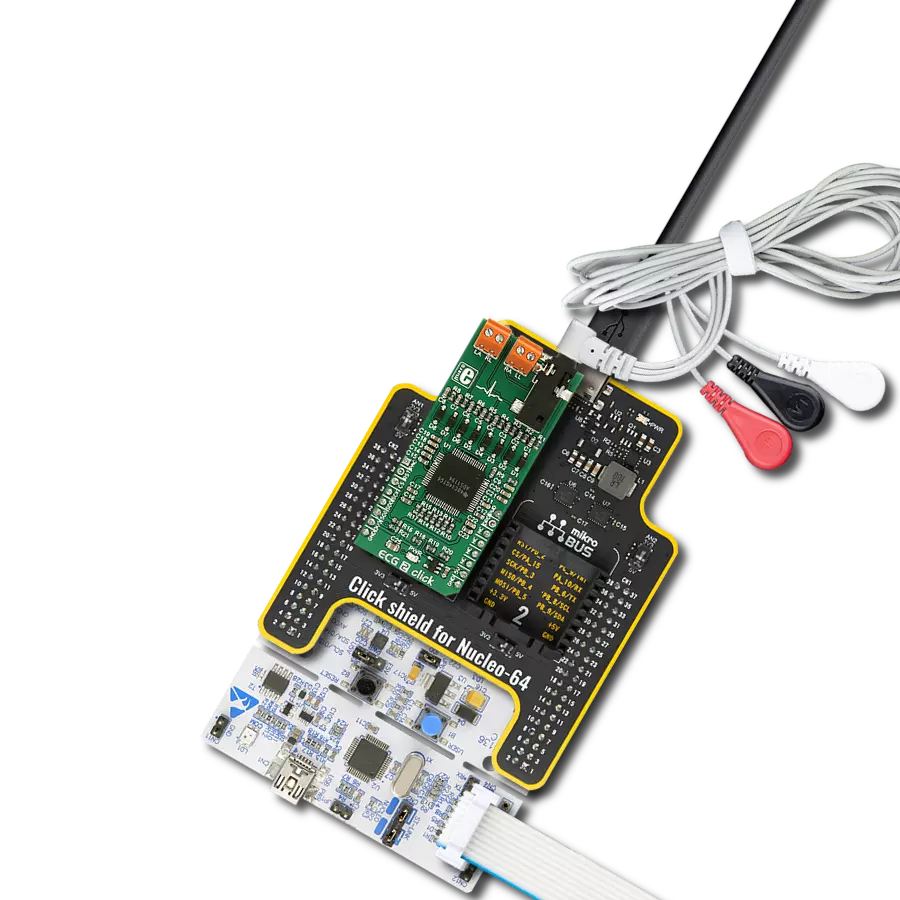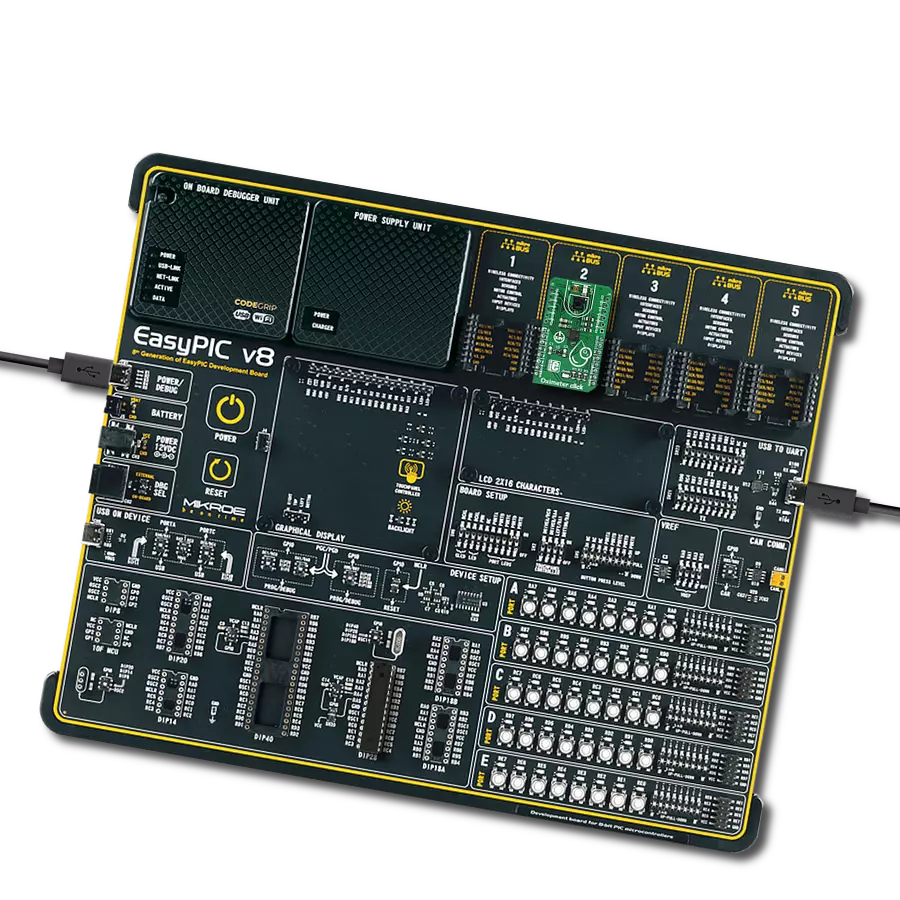Upgrade your solution's heart rate monitoring capabilities with an advanced and versatile heart rate sensor
A
A
Hardware Overview
How does it work?
Heart rate 6 Click is based on the BH1790GLC, a monolithically integrated sensor for heart rate monitoring, from ROHM Semiconductor. This IC is a highly integrated optical sensor well-suited for performing PPM measurements. Due to the large integration scale of this sensor, as well as its low power consumption, it is perfectly suited to be used on a wearable IoT device. However, being a Click board™, Heart rate 6 Click allows easy evaluation and rapid application and firmware development. Two green LEDs are driven by the integrated LED driving section of the BH1790GLC sensor, with a programmable pulsating frequency of 64Hz or 128Hz. The LED current can also be programmed from 0 to 60 mA. Finally, there are two settings for the pulse duration: 0.3ms and 0.6ms. These two values affect the duty cycle of the LED pulses. Optimal readings can be achieved by balancing these three parameters: the current amount through the LED (brightness), the speed
of the light pulses (LED frequency), and the pulse width (0.3ms or 0.6ms) The reflected light burst is detected by a sensing element as a photo-diode, sampled by a low-noise 16-bit A/D converter. The photo-diode is located behind two light filters which pass only a narrow band of green light in the range from 520nm to 560nm, with 0.8X reduction with respect to the center frequency. The top filter is an IRCUT filter that prevents the influence of the IR light, while the second filtering layer only passes the green light. This allows an even broader color range of LEDs to be used, reducing the overall cost of the design. However, Heart rate 6 Click uses the KingBright super bright clear green LEDs, with a spectral response that is closely matched to the passband properties of the optical filter. This allows most of the LED energy to be used, further improving the power consumption profile. Two output registers contain the 16-bit measurement as two 8-bit words.
The upper and the lower 8-bit registers contain the measurement data, which can be retrieved over the standard I2C interface. The host MCU can read these registers in cycles of 1/32 sec or 1/64 sec, depending on the BH1790GLC settings. The datasheet of the BH1790GLC contains the correct algorithms, which describe the measurement process in more detail. However, the Click board™ comes with the library, which contains functions that allow measurements to be performed with minimum effort. The I2C pins of the BH1790GLC sensor are routed to the respective mikroBUS™ I2C pins. The I2C bus lines are already equipped with two pull-up resistors, which, together with the two external LEDs, are the only components required by the BH1790GLC sensor. Pull-up resistors are connected to the 3.3V power rail so that the Click board™ can be used only with MCUs that use logic levels up to 3.3V for communication.
Features overview
Development board
Nucleo 32 with STM32F031K6 MCU board provides an affordable and flexible platform for experimenting with STM32 microcontrollers in 32-pin packages. Featuring Arduino™ Nano connectivity, it allows easy expansion with specialized shields, while being mbed-enabled for seamless integration with online resources. The
board includes an on-board ST-LINK/V2-1 debugger/programmer, supporting USB reenumeration with three interfaces: Virtual Com port, mass storage, and debug port. It offers a flexible power supply through either USB VBUS or an external source. Additionally, it includes three LEDs (LD1 for USB communication, LD2 for power,
and LD3 as a user LED) and a reset push button. The STM32 Nucleo-32 board is supported by various Integrated Development Environments (IDEs) such as IAR™, Keil®, and GCC-based IDEs like AC6 SW4STM32, making it a versatile tool for developers.
Microcontroller Overview
MCU Card / MCU
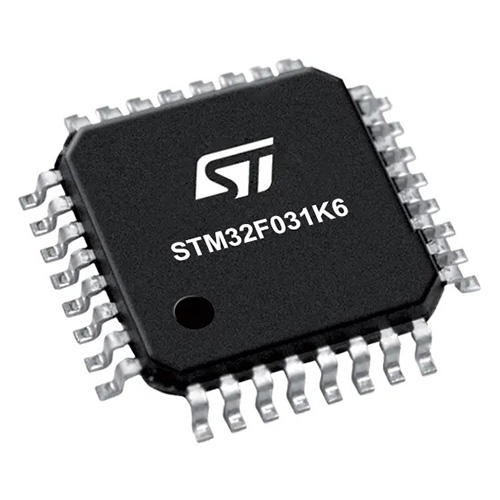
Architecture
ARM Cortex-M0
MCU Memory (KB)
32
Silicon Vendor
STMicroelectronics
Pin count
32
RAM (Bytes)
4096
You complete me!
Accessories
Click Shield for Nucleo-32 is the perfect way to expand your development board's functionalities with STM32 Nucleo-32 pinout. The Click Shield for Nucleo-32 provides two mikroBUS™ sockets to add any functionality from our ever-growing range of Click boards™. We are fully stocked with everything, from sensors and WiFi transceivers to motor control and audio amplifiers. The Click Shield for Nucleo-32 is compatible with the STM32 Nucleo-32 board, providing an affordable and flexible way for users to try out new ideas and quickly create prototypes with any STM32 microcontrollers, choosing from the various combinations of performance, power consumption, and features. The STM32 Nucleo-32 boards do not require any separate probe as they integrate the ST-LINK/V2-1 debugger/programmer and come with the STM32 comprehensive software HAL library and various packaged software examples. This development platform provides users with an effortless and common way to combine the STM32 Nucleo-32 footprint compatible board with their favorite Click boards™ in their upcoming projects.
Used MCU Pins
mikroBUS™ mapper
Take a closer look
Click board™ Schematic

Step by step
Project assembly
Software Support
Library Description
This library contains API for Heart rate 6 Click driver.
Key functions:
heartrate6_get_data- Function reads the LED Data as 16bit unsigned valueheartrate6_set_freq- Function sets the data reading frequency and the LED pulse frequencyheartrate6_start_measure- Function starts measurement cycle
Open Source
Code example
The complete application code and a ready-to-use project are available through the NECTO Studio Package Manager for direct installation in the NECTO Studio. The application code can also be found on the MIKROE GitHub account.
/*!
* \file
* \brief HeartRate6 Click example
*
* # Description
* The example demonstrates the use of Heart rate 6 Click board.
*
* The demo application is composed of two sections :
*
* ## Application Init
* Initializes interface and performs the device configuration and reset.
*
* ## Application Task
* Waits until measurement cycle is finished and data is ready for reading.
* Then reads the LED data and performs the data plotting on USB UART.
*
* \author MikroE Team
*
*/
// ------------------------------------------------------------------- INCLUDES
#include "board.h"
#include "log.h"
#include "heartrate6.h"
// ------------------------------------------------------------------ VARIABLES
static heartrate6_t heartrate6;
static log_t logger;
static uint16_t led_data_off;
static uint16_t led_data_on;
static uint8_t counter = 200;
// ------------------------------------------------------ APPLICATION FUNCTIONS
void application_init ( void )
{
log_cfg_t log_cfg;
heartrate6_cfg_t cfg;
/**
* Logger initialization.
* Default baud rate: 115200
* Default log level: LOG_LEVEL_DEBUG
* @note If USB_UART_RX and USB_UART_TX
* are defined as HAL_PIN_NC, you will
* need to define them manually for log to work.
* See @b LOG_MAP_USB_UART macro definition for detailed explanation.
*/
LOG_MAP_USB_UART( log_cfg );
log_init( &logger, &log_cfg );
log_info( &logger, "---- Application Init ----" );
// Click initialization.
heartrate6_cfg_setup( &cfg );
HEARTRATE6_MAP_MIKROBUS( cfg, MIKROBUS_1 );
heartrate6_init( &heartrate6, &cfg );
Delay_ms ( 500 );
heartrate6_default_cfg( &heartrate6 );
log_printf( &logger, " Heart rate 6 is initialized. \r\n");
Delay_ms ( 500 );
}
void application_task ( void )
{
heartrate6_wait_measure( &heartrate6 );
heartrate6_get_data( &heartrate6, &led_data_off, &led_data_on );
counter++;
if ( led_data_off < 200 )
{
log_printf( &logger, "%u;\r\n", led_data_on );
counter = 200;
}
else if ( counter > 200 )
{
log_printf( &logger, "Please place your index finger on the sensor.\r\n" );
counter = 0;
}
}
int main ( void )
{
/* Do not remove this line or clock might not be set correctly. */
#ifdef PREINIT_SUPPORTED
preinit();
#endif
application_init( );
for ( ; ; )
{
application_task( );
}
return 0;
}
// ------------------------------------------------------------------------ END
Additional Support
Resources
Category:Biometrics



